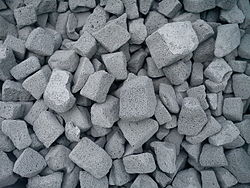Foam glass granulate
| Glass foam granulate | |
|---|---|
 Glass foam granulate with a grain size of 3–5 cm |
|
| origin | |
| raw materials | Waste glass and additives |
| Primary energy consumption (production) | 750-1,600 kWh / m³ |
| Material properties | |
| Thermal conductivity λ | 0.07-0.09 W / (m K) |
| Specific heat capacity c | 840-1,100 J / (kg K) |
| Bulk density ρ | 130-200 kg / m³ |
| Vapor diffusion resistance μ | 1-3 |
| commitment | |
| Areas of application | see usage |
Foam glass granulate (foam glass gravel, glass foam gravel) is a mineral lightweight construction material that is made from pure waste glass and is used for thermal insulation and stabilization. The granulate consists of broken foam glass and enables building without thermal bridges . Its properties are high pressure stability, protection against pests and non-rot. The material is CFC- free, non-flammable and easy to process because it is poured into the excavation as a loose fill and compacted.
Manufacturing
For production, waste glass is ground and heated to approx. 900 ° C with the addition of a binding agent and an expanding material. The material breaks when it cools and solidifies. The resulting loose grain has a closed cell structure and a firm consistency. The high amount of trapped air ensures good insulation properties and a low density of 130 to 170 kg / m³.
use
Foam glass granulate is mainly used as load-bearing perimeter insulation under floor slabs, as a road substructure and for insulating components. There is no need for the usual layer structures for insulation against the ground, such as capillary-breaking layers, blinding layers, XPS panels and the frost apron (for buildings without a basement).
In 2018, foam glass granulate was used for the renewal of a section of the B 472 in order to prevent further settlement of the peat floor in the access area of a bridge due to its lighter weight.
Individual evidence
- ↑ a b see foam glass
- ↑ a b page 59 of the guide to the selection of insulation materials for standard-compliant use by Bauzentrum München
- ^ V. Ahn-Tauchnitz: A visit to the B472 construction site: “Not a simple story” . In: Münchner Merkur . June 28, 2018. Retrieved July 4, 2018.